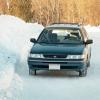Search the Community
Showing results for tags 'road salt'.
-
The question comes up occasionally about used cars from the northern U.S., and how rust is a problem. I came across a map that shows the amount of road salt used in the U.S. The map tells most of the story, but there is more to the problem. Where I live in Wisconsin, the road salt season is anytime temperatures drop below freezing. Our road salt season is about 6 months long, as early as October, to April. The severity of the cold prevents washing cars unless you have access to a heated structure for thawing the glaciers in the wheel wells, and flushing the undercarriage. Last winter we had 60 days with a low temperature of 0ºF or colder. Even if it warms up enough to wash the car, in two blocks driving away from the car wash, the car is bathed in salt water/slush/spray again. The undercarriage flush at the automatic car wash doesn't even begin to wash out the wheel wells. Finally, the amount of snow throughout the season means there is always new snow, sand, and salt being packed into the wheel wells forming a gritty block of dirty salty ice. The map below shows the depth of snow cover on March 10, 2014. The photos of my car show how much ice packs in the wheel wells. During a couple of days in early February that were sunny and around 20º, the wheel wells started to thaw, and I estimated about 30# of snow/ice/sand/salt came out of each wheel well. The photo with the snow shovel shows what came out of one wheel well. They packed full again anyway. I'm sure those of you who live right on the coasts with salt in the air have your own rust issues, but this is why we like to find "southern cars" when shopping for used!







